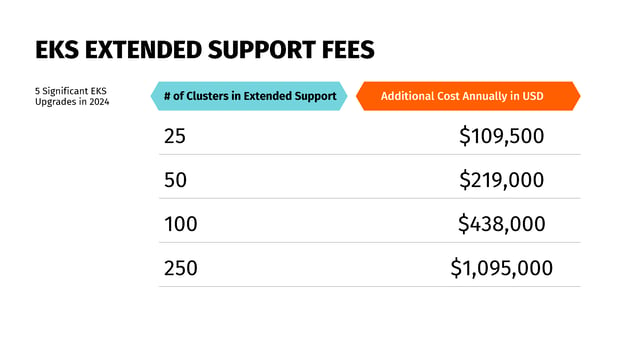Amazon Web Services (AWS) announced extended support prices for Amazon Elastic Kubernetes Service (EKS), prompting some businesses to reevaluate how they manage their cloud infrastructure and financial operations. For those that missed it, the key takeaway is that EKS extended support will cost 6x what standard support did. The switch to extended support occurred on January 31 for v1.24, and will go into effect on May 1 for v1.25, June 11 for v1.26, and July 24 for v1.27. For some organizations, these could result in a significant increase in cloud costs. These cost increases impact budgeting but also bring greater attention to version control as a critical responsibility for FinOps teams.
Understanding AWS Extended Support Price Increases
Recent changes to the AWS pricing model for extended support services introduced new cost dynamics for businesses that rely on EKS. The control plane, critical to Kubernetes clusters, now costs $0.60 per hour per cluster for EKS as opposed to the normal $0.10. Kubernetes and EKS release three to four versions per year and EKS typically offers 14 months of standard support after the release date. That means you need to have a continuous process in place for updating your clusters to ensure that you stay on supported EKS versions.
EKS extended support automatically gives you an extra year to catch up if you fall behind, but it’s not a comfortable spot to be in because of the additional costs. Plus, you will need to upgrade eventually. Amazon EKS does send a notice through the AWS Health Dashboard about 12 months after the Kubernetes version was released on Amazon EKS, which includes the end of support date (about 60 days from the date of notice).

FinOps, Version Control, and Cost Management
Based on these extended support fees, version control becomes an important aspect of financial operations in technology-driven companies. FinOps teams must now navigate these price increases, working to ensure that EKS is in standard support to avoid the high costs associated with extended support. This change underscores the importance of considering AWS end of service life management as an aspect of financial planning, yet another reason to embrace FinOps when it comes to cloud infrastructure cost management.
Build a Business Case for Upgrades
While the hit of extended support costs presents a challenge, it’s also an opportunity for organizations to reevaluate their cloud infrastructure and upgrade processes. By identifying the need for an upgrade as an investment rather than a basic cost, FinOps teams can create a compelling business case for keeping their technology stack up to date with newer versions. This perspective will help organizations avoid extended support fees and ensure use of the latest features and improvements in Kubernetes.
The Cost of Inaction
There are tangible costs associated with remaining on outdated versions after standard support expires. Platform engineering teams can leverage extended support fees as a clear metric that demonstrates the financial impact of inaction, showing a quantifiable incentive for pursuing timely upgrades, whether that is completed in-house or through a service provider .
Operational Efficiency, Compatibility, and Performance
Beyond cost avoidance, upgrading to an EKS version in standard support offers significant benefits in terms of operational efficiency, compatibility with newer software in the cloud native ecosystem , and performance. Outdated versions may have performance limitations that cause increased latency and reduced throughput. Plus, running unsupported versions makes it harder to get help from a community that’s currently focused on the latest version of Kubernetes. And using the latest supported version enhances security because it includes the newest security patches to protect your infrastructure against newly disclosed vulnerabilities and evolving threats.
Simplify Upgrades and Operations
For businesses strained by the constant cycle of Kubernetes upgrades and related operational tasks, managed services offer a compelling alternative. Outsourcing the management of Amazon EKS services to a dedicated team of Kubernetes experts can alleviate the stresses of version control, allowing businesses to focus on their core activities, accelerate their time-to-market, and deploy applications with confidence.
Offload the Upgrade Cycle
Managed service providers specialize in maintaining up-to-date infrastructure, ensuring that businesses can benefit from the latest AWS features without the challenges of managing the upgrade process with internal resources. For many organizations, K8s upgrades require time from your senior engineers to prepare, research, and test before rolling out the changes. Leveraging managed services both minimizes the risk of paying extended support fees and enables internal resources to focus your organization’s strategic initiatives.
Eliminate the Pager Burden
Beyond upgrade management, managed services can also take on the operational responsibilities associated with cloud infrastructure, including on-call duties for your infrastructure. It can be difficult to hire the right person to carry responsibility for the pager, because you need a site reliability engineer who is experienced enough to handle all your organization’s internal needs who is also willing to carry a pager. Outsourcing responsibility for your Kubernetes infrastructure ensures that your infra is quiet and secure , so you can skip those 3 AM pages if there’s an infrastructure issue.
Transform an EKS Challenge into a FinOps Opportunity
AWS's extended support price increases illustrate a change in how businesses need to manage their cloud infrastructure management. By viewing version control as a key FinOps responsibility and approaching EKS upgrades as strategic investments, engineering teams can navigate these changes to better manage cloud spend and Kubernetes infrastructure. Partnering with a managed service provider can help organizations quickly upgrade to a supported version of EKS, improving reliability, security, and cost efficiency.


